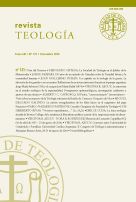Por favor, use este identificador para citar o enlazar este ítem:
https://repositorio.uca.edu.ar/handle/123456789/7310| Título: | El Padre, “causa-principio” intratrinitario : nota sobre un aspecto de la Teología trinitaria de Basilio de Cesarea y Gregorio de Nisa The Father, intratrinitarian “cause-principle” : note on an aspect of the trinitarian theology of Basil of Caesarea and Gregory of Nyssa |
Autor: | Capboscq, Alberto C. | Palabras clave: | Basilio de Cesarea, Santo, 329-379; Gregorio de Nisa, Santo, m. 394; TEOLOGIA; TRINIDAD; DIOS PADRE | Fecha de publicación: | 2016 | Editorial: | Universidad Católica Argentina. Facultad de Teología | Cita: | Capboscq, Alberto C., El Padre, “causa-principio” : nota sobre un aspecto de la Teología trinitaria de Basilio de Cesarea y Gregorio de Nisa [en línea]. Teología, 121 (2016). Disponible en: https://repositorio.uca.edu.ar/handle/123456789/7310 | Resumen: | Resumen: El carácter fontal del Padre dentro de la Trinidad es un tema discutido siempre de nuevo en la Teología Trinitaria y, en ese contexto, se suele apelar a los Padres Capadocios. La presente nota quiere documentar el uso de las nociones de “principio-causa” (ἀρχή - αἰτία) en la producción teológica de Basilio de Cesarea y Gregorio de Nisa. Abstract: The fontal character of the Father within the Trinity is a topic always discussed again in Trinitarian Theology and, in this context, often it appeal’s to the Cappadocian Fathers. This note wants to document the use of the notions of “principle-cause” (ἀρχή - αἰτία) in the theological works of Basil the Great and Gregory of Nyssa. |
URI: | https://repositorio.uca.edu.ar/handle/123456789/7310 | ISSN: | 0328-1396 | Disciplina: | TEOLOGIA | Derechos: | Acceso Abierto | Fuente: | Teologia, 53(121), 2016 ISSN 0328-1396 |
| Aparece en las colecciones: | TEO - 2016 Tomo LIII nro. 121 |
Ficheros en este ítem:
| Fichero | Descripción | Tamaño | Formato | |
|---|---|---|---|---|
| padre-causa-principio-intratrinitario.pdf | 563,66 kB | Adobe PDF |  Visualizar/Abrir |
Visualizaciones de página(s)
252
comprobado en 27-abr-2024
Descarga(s)
248
comprobado en 27-abr-2024
Google ScholarTM
Ver en Google Scholar
Este ítem está sujeto a una Licencia Creative Commons

